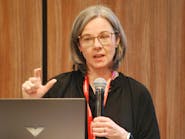Turning power scarcity into market participation
There’s a looming crisis threatening industrial facilities. Power scarcity and security are creating uncertainty around operational continuity, safety and profitability, but where there’s trouble, there’s also opportunity. All it takes is a little outside-the-box thinking and modern technology advancement and you too can not only shore up your facility’s energy usage but also make some extra revenue by joining the energy markets.
“We have to manage power supply and demand in different, more modern ways,” Prudence Hoffman, director of business development for Honeywell AutonomyX, told an audience of users and partners at the Honeywell Users Group EMEA in The Hague, Netherlands, on Nov. 13.
Rising global electricity demand is one of the top reasons for the power uncertainty plants and facilities face. Demand grew 4% in 2024, driven by cloud computing, cryptocurrency, electrification, and even extreme heatwaves across the globe. “The demand will get even more intense and more than double by 2050,” Hoffman added.
Other factors include an overloaded and aging grid infrastructure that needs modernization, inconsistent renewable energy output, and the necessary increase in data centers to drive artificial intelligence (AI) growth.
It all adds up to mounting pressure on commercial and industrial sites with limited capital. While the simple answer may seem to be modernization, new grid infrastructure poses new risks such as load curtailments, power quality issues and safety challenges. Hoffman said industrial sites are more at risk due to their high-load operations and power-transient events. Ramifications of power supply interruptions, in turn, include unplanned shutdowns, loss of revenue and damage to equipment.
Empowering resilience
Luckily, there’s actions a site can take to mitigate the unpredictability. At Honeywell, it’s called “predict, prevent, reduce.” Hoffman said there are solutions to predicting power transient events and other external influences for the facility’s on-site power. Among them are an asset performance manager, predictive analytics and the use of Forge Performance+ for utilities, which supports grid balancing.
“There are different ways we can minimize the risks to the site,” Hoffman said.
Preventative solutions, such gas and turbine controls, proactive maintenance, remote operations and cybersecurity, can keep the transient event from even happening. If the transient event cannot be prevented, there are solutions to reduce the impact of the event, including Experion integration, microgrid controls and dynamic load shedding.
Market opportunity
One creative way to mitigate this insecurity is for a site to actively take part in energy markets and even earn revenue through automated controls that help stabilize the grid during peak demand or transient events.
“There’s an opportunity for these sites to look outward and start participating in the energy market,” Hoffman said. “It allows you to make some additional revue.”
But first sites must figure out their value and optimize their energy usage. GridBeyond is a company that partners with Honeywell and works together with sites to unearth the full potential of their energy assets. It acts as a conduit between those sites and energy market participation.
It follows a concept of intelligent energy optimization in which it uses advanced solver-based optimization and digital twin technology to unlock elevated levels of site flexibility, without impacting production targets. It uses an automated approach that incorporates the site’s production plans and key asset parameters.
Another way to make power to the site more secure is the use of on-site generation such as microgrids and energy storage. Microgrids produce power locally using renewable and conventional sources, increasing energy resilience and autonomy. Storage systems make excess power available for later use, enhancing reliability.
Meanwhile, advanced controls and dynamic integration of external data and optimization algorithms ensure efficient dispatch of distributed energy assets. That’s where automation technologies such as digital twins and AI-enhanced predictive models can make a significant difference.
Execution path
Hoffman said the way to begin is with pilot site identification. Companies must establish pilot sites with flexible load profiles and energy market access to be able to tap into the grid easily.
Conducting energy review and feasibility studies assess cost savings, revenue potential and operational improvement. Control systems can be deployed to enable real-time market participation and adaptive scheduling for energy management.
Finally, integration with digital platforms ensures continuous monitoring, optimization and alignment with strategic goals. In the end, a site’s ability to operate efficiently will become much more certain.

